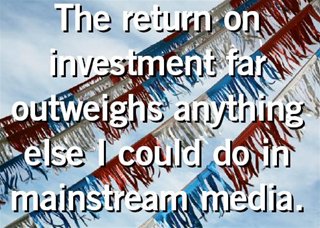 ≡
≡
Shifting Newspaper Advertising To Radio And Online Pays Big
Nov 20, 2006 by Sean Luce Scoping out the Oct. 2 issue of Automotive News, I noticed an article about a car dealer in Sacramento, CA. David Shirley, the general manager of Folsom Chevrolet, pulled $80,000 per month out of newspaper advertising, and put most of it into radio. I've witnessed this before, but because car dealers often can't quantify the results of the radio advertising after they jump, they end up putting their money right back into print. Not this time! Folsom Chevrolet is on board with radio, and it's there to stay. I called David Shirley to find out what convinced him to choose radio at a time when others in his industry are sending their broadcast dollars to the Internet.
Scoping out the Oct. 2 issue of Automotive News, I noticed an article about a car dealer in Sacramento, CA. David Shirley, the general manager of Folsom Chevrolet, pulled $80,000 per month out of newspaper advertising, and put most of it into radio. I've witnessed this before, but because car dealers often can't quantify the results of the radio advertising after they jump, they end up putting their money right back into print. Not this time! Folsom Chevrolet is on board with radio, and it's there to stay. I called David Shirley to find out what convinced him to choose radio at a time when others in his industry are sending their broadcast dollars to the Internet. SEAN LUCE:
Why did you take $80,000 a month out of newspaper and put it into radio?DAVID SHIRLEY:
I wasn't seeing a return on investment for the $80,000 per month I was sinking into newspapers. I first had to change the paradigm of what car dealers do in newspaper.We usually run two to three full-page color ads a week, with price and item, and put a big promotional spin on it. But I wanted to have frequency and reach ? not only to the Boomers, but also to Generation X and Y. TV is too fragmented, so we dramatically cut back on that medium. Radio was the natural choice. I could gauge my ROI from radio by knowing exactly when my ads were running on which stations.SL:
What was the name of your radio campaign?DS:
Shop Naked.We branded this message for three months. I had a 9.0 frequency in the total market. Instead of having one voice run over multiple stations, each station used a voice that the listeners already had a relationship with. Our message was very demospecific, and changed to fit the target audience on each station.SL:
How did you track your results?DS:
I have different messages running on different stations. I also run different tile or banner ads on the stations' websites, so I can tell which website they are coming from. In our market, 1.2 million of the 1.8 million people are Internet connected. I can drive whatever traffic I want to my website, and the traffic coming into the dealership now is much better-qualified than what the newspaper was providing. My goal was to track on a daily basis where my leads were coming from, and now I am able to do that. When we started, we promoted only used cars. Our used cars were selling like hotcakes, but new car sales went down.We shifted gears and started promoting new cars, and new car sales went up. We are now doing a 50-50 split of new/used car ads on the radio, and sales on both are up substantially. In terms of ROI, this has been the best advertising I have ever done.The Shop Naked campaign is now branded because of our huge share of voice in the market.SL
: Web traffic is a big part of your strategy. Do you think it's important to integrate the Internet into a radio advertising campaign?DS:
Radio needs to realize the value of the interactive relationship between listeners and the Internet. On the radio,we used :60s when we launched our three-month branding campaign; now we are running :30s with the basic message, and sending people directly to our website, or via the radio stations' site.We cut our TV spot schedules, and are now buying only the TV stations' websites. As for web maintenance, I spend 10 minutes per day changing the cars on our site, so the maintenance issue is very small.SL
: What advice do you have for radio stations that aren't using the Internet as an advertising tool?DS:
You have an opportunity to use your radio stations as a directional tool to your website, and to send listeners to advertiser's websites. It's affordable, and the return on investment far outweighs anything else I could do in mainstream media. It's also good to be first; once you brand a campaign and dominate the share of voice, it's tough for competitors to infringe on your territory.You can do exactly what David Shirley is doing with your radio stations.You don't need a state-of-the-art website, as long as the client has an effective one, with images and the ability to change content dailyRelated Categories
> Publications > Radio Ink




